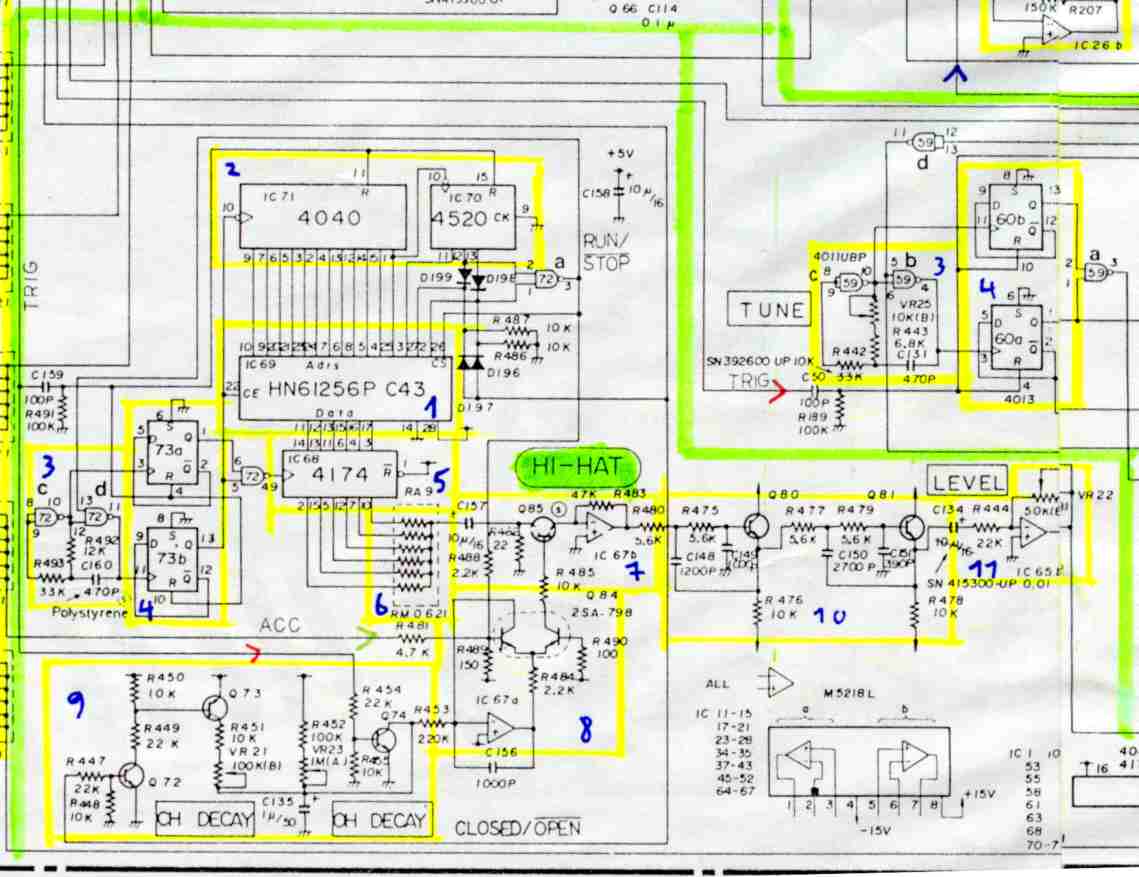
HiHat and Cymbals

> = Trig |
> = Accent or Velocity (from D/A) |
> = Noise |
HiHat, Ride and Crash cymbals are 6-Bit (!) samples. Circuit configurations and operations of these voices are basically the same. The following description takes HiHat as a representative.
Pressing HiHat button(s) develops a positive pulse (TRIG), resetting Address Counters IC70 and IC71 (part2) to have "0's" on their outputs. These 0's cause IC72a output to swing to H irrespective of a Closed/Open being applied to diode OR's (D196-199, necessary to distinguish between Closed and Open HiHat). Upon receiving this "run" from IC72a, a simple oscillator composed of two NAND-gates (no crystal!!) starts oscillation and outputs about 60kHz (see part 3), which is divided by two and shaped up by IC73 D-Flip-Flop (see part 4), clocking the address counters (pin10 of IC70,71). IC69 (ROM, see part 1) starts clocking out voice data, which are latched into IC68 Hex D-FlipFlop (see part 5) and then converted to analog voltages while passing through RA9 (resistor network, see part 6). This is a very simple configuration for a D/A-Converter. According to the resolution of 6-Bit, the sounds have been compressed before being digitalized in order to have a greater S/N ratio and higher digital resolution. The original envelope is reproduced by a VCA, which is controlled by an envelope.
Open/Closed decay times of this envelope can be regulated individually. This is realised by a little bit tricky circuit (see part 9).
A high Closed/Open (Closed HiHat selected) on Q72 base removes a positive voltage from its collector which in turn allows Q73 to charge decay capacitor C135 through R451 and VR21 (CH Decay). Since this charging path is 1/10 the total resistance of R452 and VR23, the charging rate of C135 depends on VR21 setting only (better say almost). With low Closed/Open (Open HiHat selected), CH charging path is disconnected from the DC supply source at Q73 and OH path becomes conductive. Charging rate of C135 now depends on R452 and VR23 (OH Decay). A disadvantage of this circuit is, that CH Decay is changing slightly when turning OH-Decay (VR23). But this change will not be notified in most cases.
Envelope output passes through an Anti-Log (part 8) to provide a more realistic shape of the Env-signal, which drives the VCA (part 7). Finally HiHat signal is lowpass-filtered (two LPF's in serial, see part 10) to remove unwanted high frequencies after D/A conversion. Level control is provided by an amplifier (part 11)
Some notes on Crash and Ride
These voices also have unique envelopes that are quite different from actual sounds when the data is directly reproduced. The reason is the same as described in HiHat section. According there is no decay-control, restoration of the envelopes are made by the use of ROM addresses as the envelope data. When Crash (Ride) sound data are read successively from ROM with correct addresses, the same addresses are also converted to analog voltage (by a second D/A), anti-log tapered and applied to the VCA. This way of generating the envelope is necessary, because tuning of the instrument is possible. As the signal gets shorter at higher tunings, the decay-time has to change in the same manner.